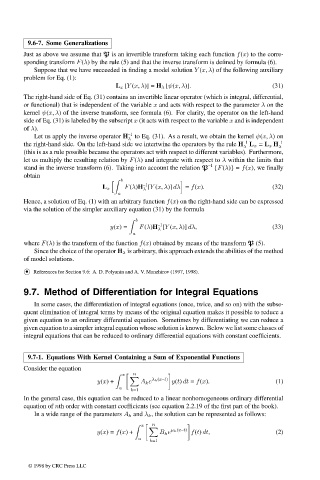Page 501 - Handbook Of Integral Equations
P. 501
9.6-7. Some Generalizations
Just as above we assume that P is an invertible transform taking each function f(x) to the corre-
sponding transform F(λ) by the rule (5) and that the inverse transform is defined by formula (6).
Suppose that we have succeeded in finding a model solution Y (x, λ) of the following auxiliary
problem for Eq. (1):
L x [Y (x, λ)] = H λ [ψ(x, λ)]. (31)
The right-hand side of Eq. (31) contains an invertible linear operator (which is integral, differential,
or functional) that is independent of the variable x and acts with respect to the parameter λ on the
kernel ψ(x, λ) of the inverse transform, see formula (6). For clarity, the operator on the left-hand
side of Eq. (31) is labeled by the subscript x (it acts with respect to the variable x and is independent
of λ).
Let us apply the inverse operator H –1 to Eq. (31). As a result, we obtain the kernel ψ(x, λ)on
λ
–1
the right-hand side. On the left-hand side we intertwine the operators by the rule H L x = L x H –1
λ
λ
(this is as a rule possible because the operators act with respect to different variables). Furthermore,
let us multiply the resulting relation by F(λ) and integrate with respect to λ within the limits that
–1
stand in the inverse transform (6). Taking into account the relation P {F(λ)} = f(x), we finally
obtain
b
–1
F(λ)H [Y (x, λ)] dλ = f(x). (32)
L x
λ
a
Hence, a solution of Eq. (1) with an arbitrary function f(x) on the right-hand side can be expressed
via the solution of the simpler auxiliary equation (31) by the formula
b
–1
y(x)= F(λ)H [Y (x, λ)] dλ, (33)
λ
a
where F(λ) is the transform of the function f(x) obtained by means of the transform P (5).
Since the choice of the operator H λ is arbitrary, this approach extends the abilities of the method
of model solutions.
•
References for Section 9.6: A. D. Polyanin and A. V. Manzhirov (1997, 1998).
9.7. Method of Differentiation for Integral Equations
In some cases, the differentiation of integral equations (once, twice, and so on) with the subse-
quent elimination of integral terms by means of the original equation makes it possible to reduce a
given equation to an ordinary differential equation. Sometimes by differentiating we can reduce a
given equation to a simpler integral equation whose solution is known. Below we list some classes of
integral equations that can be reduced to ordinary differential equations with constant coefficients.
9.7-1. Equations With Kernel Containing a Sum of Exponential Functions
Consider the equation
n
x
y(x)+ A k e λ k (x–t) y(t) dt = f(x). (1)
a
k=1
In the general case, this equation can be reduced to a linear nonhomogeneous ordinary differential
equation of nth order with constant coefficients (see equation 2.2.19 of the first part of the book).
In a wide range of the parameters A k and λ k , the solution can be represented as follows:
n
x
y(x)= f(x)+ B k e µ k (x–t) f(t) dt, (2)
a
k=1
© 1998 by CRC Press LLC
© 1998 by CRC Press LLC
Page 483

